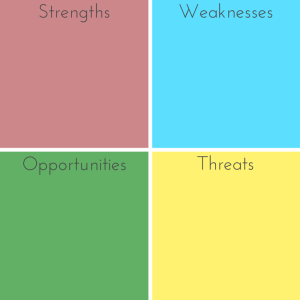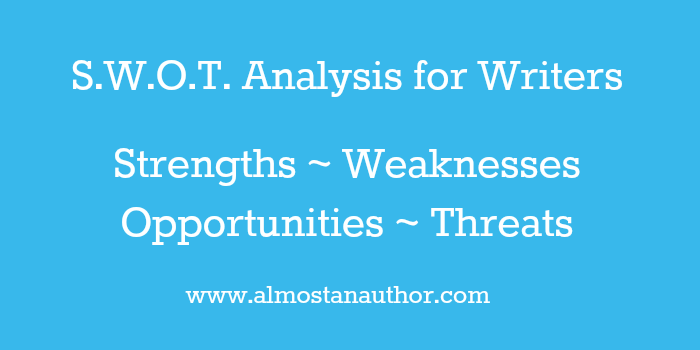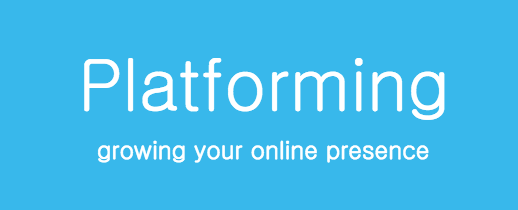Occasionally a business development tool comes along that works well for writers.
SWOT Analysis
SWOT—Strengths, Weaknesses, Opportunities and Threats—was popularized in the 1960s by management consultant Albert S Humphrey. This planning model helps managers develop marketing and project strategies.
Writers can also apply the SWOT Analysis to grow their platform. Your goal is to look objectively at the following four areas (a critique partner may help you think through your lists):

Strengths and weaknesses are the internal factors you can control. Opportunities and threats are the external factors you can’t control.
A worksheet is available in this download: SWOT Analysis for Writers
Strengths
Make a list of things you do well. Include professional skills as well as strong personal habits, such as:
- relationships with other writers,
- keeping a consistent posting schedule,
- keeping up with trends,
- concise writing skills,
- attention to your social media network,
- ability to self-edit,
- strong vocabulary,
- self-discipline,
- commitment to learn and grow,
- focus,
- determination,
- thick skin.
Weaknesses
List your weak areas, being brutally honest:
- procrastination,
- being easily discouraged or distracted,
- balking at critique,
- insecurity,
- lack of discipline,
- apathy,
- overly critical,
- pessimistic attitude,
- isolating yourself from other writers, or perhaps even friends and family.
Opportunities
What opportunities did you have last year? What opportunities are on the horizon? Are you aware of any writing or publishing trends that may benefit you?
Threats
What external factors, factors out of your control, could sidetrack your writing progress this year?
The Analysis
Once you’ve compiled your lists, ask these four questions:
- What can you do to continue making progress in your areas of strengths?
- How will you position yourself to take advantage of your opportunities?
- What can you do to turn your weaknesses into strengths?
- How might you guard against threats, or avoid them altogether?
A personal SWOT Analysis can help writers develop a strategy that minimizes their chances for discouragement and maximizes their potential for success. Download your worksheet here: SWOT Analysis for Writers
Shareables:

[bctt tweet=”Want to grow your #writer platform? SWOT Tips via @A3forme @susanrstilwell ” via=”no”]
[bctt tweet=”Identifying weaknesses and threats to enhance your #writer platform, via @A3forme @susanrstilwell ” via=”no”]
[bctt tweet=”Maximize success, minimize failure to build a #writer platform via @A3forme @susanrstilwell ” via=”no”]
[bctt tweet=”4 critical areas to evaluate to grow your #writer platform, @A3forme @susanrstilwell ” via=”no”]






3 Comments
Once again, God’s timing is perfect. He really makes me laugh sometimes. Thank you for this helpful post. I think I could simply ditto the first two of your list and be halfway done. I am going to explore this further today and share it with a few young aspiring student writers I know. Thanks again Susan!
P.S. I struggle with protecting my privacy and sharing which ultimately results in no platform. Is it fear aspiring writers may possess? Is this normal? God give me the courage to write and be open to share. . .
I’m glad you found it helpful, Bobbi. And I hope your students benefit from their personal analyses!
As for fear, it’s normal for me. Sharing our personal stories is risky. What if we offend someone? What if they misinterpret what we say? What if they flat-out don’t like what we say??
It’s a vulnerable position to be sure. Yes, God give us courage.